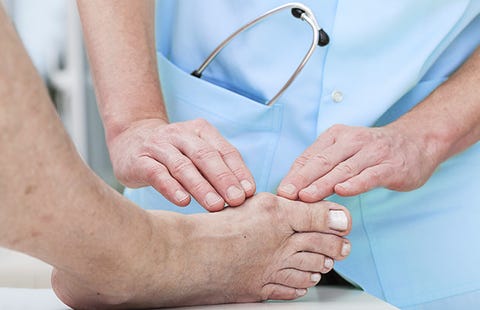How to Get Rid of Bunions Without Surgery
That painful bump on the side of your big toe? That's a bunion, a deformity that occurs when the base of the big toe pushes outward. Bunions often run in families, and they're more common in women, who tend to wear high-heeled, ill-fitting shoes that can put pressure on the foot bones. (Want to pick up some healthier habits? Sign up to get healthy living tips delivered straight to your inbox!)
Nearly a quarter of adults ages 18 to 65 develop bunions, according to a study in the Journal of Foot and Ankle Research. The risk goes up from there: 36% of people over age 65 have them.
If you count yourself among the ranks of bunion sufferers, you might be wondering if surgery (bunionectomy) is worth it. Here's what you should know before going under the knife.
You might not need a surgical fix.

KatarzynaBialasiewicz/Getty Images
As with most things, surgery is generally a last resort. Have you tried icing the spot, changing shoes, or taking pain medication and maybe cortisone shots? If all else has failed—and your bump is large and painful—surgery probably makes sense. That's especially true if a bunion is cramping not only your style, but also your ability to go about everyday activities. "When I start to hear, 'I used to love to walk my dog, and now I can't,' that's when I steer the conversation toward surgery," says Jacqueline Sutera, DPM, a podiatric physician in New York City and member of the American Podiatric Medical Association. (Here are solutions to your 10 biggest walking pains.)
Not all bunions (and bunion surgeries) are created equal.
Bunions come in mild, moderate, and severe varieties, and there are several kinds of procedures to address each type. Surgery is most often done (and most straightforward) on moderate bunions: A doctor shaves down the bump and corrects the angular deformity of the toe joints. A small screw may be used to hold the bone in place afterward.
MORE:The 10 Most Painful Conditions
Recovery takes time.
For the most common kind of bunion surgery (for moderate cases), you can leave the hospital the same day. You'll then wear a special bootie for 3 to 4 weeks, though it takes 6 to 8 weeks total to heal. You should expect significant bruising and swelling, but how much it hurts varies. Some people just need a little ibuprofen; others need prescription painkillers and extended time off from work to recuperate.
You may also have some stiffness due to scar tissue that you'll have to work out with massages and stretches, and you may require physical therapy. "I tell people it's going to be about 3 months before I'm ready to release you to full running, jumping, weight-bearing activity," says Gregory Catalano, DPM, a podiatrist in Concord, MA, and fellow of the American College of Foot and Ankle Surgeons. (Try these exercises to heal foot pain.)
If you wait too long, it gets ugly.

bgwalker/Getty Images
If you let a bunion get too advanced, you're looking at a very different type of surgery. A foot surgeon might actually have to replace your toe joints or even fuse bones together. "There are a lot more pins and hardware and plates, and the recovery is longer," Sutera says. You'll spend time with a cast and crutches, or even a wheelchair. The takeaway: Don't wait to see a doctor.
MORE:6 Simple Moves To Ease Sciatica
You may need to postpone your travel plans.
No matter what type of surgery you have, you should expect some follow-up visits with your surgeon, and you may have post-surgery complications such as stiffness or infection. That's why it's best to stay local for a while. "If there is any sign of infection, it needs to be treated right away," says Sutera. "I prefer that people don't go to Florida to recover with their mom and have some other doctor take care of the surgery I'm responsible for."
Insurance should cover it.
Thankfully, health insurers classify bunions as deformities and usually cover surgery to correct them, but you may still owe a co-pay, co-insurance, or deductible, so it's smart to check with your provider ahead of time. "Insurance companies know that if you have foot pain, it leads to a more sedentary life," Sutera says. "It's a downward spiral. They're really good about recognizing that this is part of a bigger problem and that it does need attention."
MORE:60-Second Fix For A Stiff Neck
It's not a forever fix.
If you're genetically prone to bunions (which is often the case), your bunion may recur even if your surgery and recovery are textbook. Wearing improper shoes and injuring the area ups the chances of trouble. "I try never to tell people that they're going to get a perfect foot again," Catalano says. "There was a problem, and we're fixing it the best we can. Hopefully our correction will be tough enough to withstand the body's urge to want to get back into that position."
This content is created and maintained by a third party, and imported onto this page to help users provide their email addresses. You may be able to find more information about this and similar content at piano.io
How to Get Rid of Bunions Without Surgery
Source: https://www.prevention.com/health/a20508680/bunion-surgery/